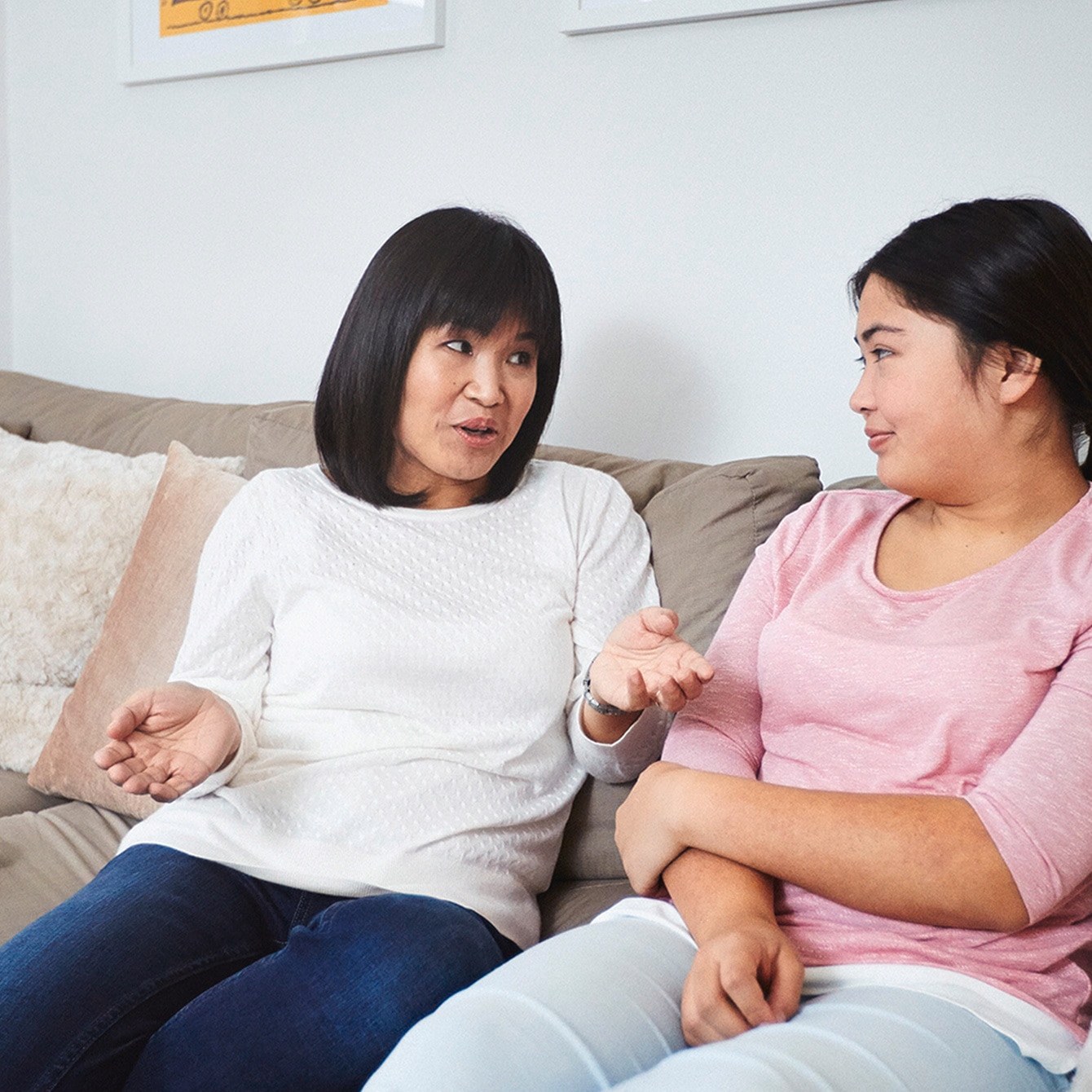หากคุณไม่แน่ใจว่าจะช่วยลูกได้อย่างไรถ้าเขาหรือเธอโดนเพื่อนล้อ ลองสังเกตหาสัญญาณต่างๆ เมื่อลูกโดนแกล้งด้วยเช็คลิสต์ที่เราออกแบบมาเพื่อช่วยให้คุณและลูกเอาชนะอุปสรรคและผ่านมันไปให้ได้
โดนล้อ เยาะเย้ย
ตอนที่ยังเป็นเด็กคุณเคยโดนล้อว่าอะไรบ้าง “สี่ตา” , “หน้าสิว” , “ไอ้อ้วน” คำพูดเหล่านี้ที่เราเคยได้ยินตอนเมื่อเด็กๆล้วนเป็นการล้อเลียนรูปลักษณ์ภายนอก
จนถึงปัจจุบันนี้ คำต่างๆเหล่านี้ก็ยังคงถูกใช้อยู่ จากการค้นคว้าของหน่วยงานราชการของประเทศอังกฤษอย่างOfsted เรื่อง No Place for Bullying พบว่าปัจจุบันนี้ก็ยังมีนักเรียนที่โดนรังแกเรื่องรูปลักษณ์ภายนอก ในโรงเรียนระดับประถมศึกษา การโดนกลั่นแกล้งจากเรื่องของลักษณะทางร่างกาย เช่น ผมแดง สูง ตัวเล็ก “อ้วน” หรือ “ผอม” ส่วนในระดับมัธยมศึกษา การกลั่นแกล้งจะเปลี่ยนเป้าหมายไปในเรื่องอื่นๆ ที่เห็นได้จากภายนอก อาทิ เสื้อผ้า ทรงผม และ เครื่องประดับ ที่ดูตกเทรนด์
แม้ว่าเด็กๆอาจมีความเห็นที่ไม่ลงรอย ทะเลาะ ล้อเลียน หรือ แซวเล่น ในกลุ่มเพื่อนกันอยู่เรื่อยๆ แต่การ ‘รังแก’ นั้นแตกต่างออกไป เว็บไซต์ของรัฐบาลสหรัฐฯ Stopbullying ได้จำกัดความคำว่า ‘รังแก’ไว้ว่า “พฤติกรรมที่ไม่เป็นที่ต้องการ ก้าวร้าว ในหมู่เด็กนักเรียน โดยมักจะเป็นการข่มเหงจิตใจให้อีกฝ่ายรู้สึกสู้ไม่ได้ ซึ่งรวมไปถึงการข่มขู่ ปล่อยข่าวลือ ทำร้ายอีกฝ่ายด้วยกำลัง หรือ คำพูด และ การไล่ออกจากกลุ่มโดยตั้งใจ”
สัญญาณที่บอกให้รู้เมื่อลูกโดนรังแก
คุณจะรู้ได้อย่างไรถ้าลูกของคุณโดนรังแก คุณพ่อคุณแม่สามารถสังเกตได้จากสิ่งต่างๆต่อไปนี้:
การเปลี่ยนแปลงด้านพฤติกรรมและอารมณ์ – แยกตัวโดดเดี่ยว หรือ ก้าวร้าวกว่าปกติ
การเปลี่ยนแปลงด้านร่างกาย – มีแผล ฟกช้ำ เสื้อผ้าขาด
ไม่อยากไปโรงเรียน – มีข้ออ้าง และแกล้งป่วย
ขาดความสนใจในสิ่งต่างๆ – โดยเฉพาะในสิ่งที่ลูกของคุณชอบทำเป็นประจำ
ส่วนสัญญาณด้านล่างนี้นั้นบ่งบอกให้รู้ว่าอาจถูกรังแกในเรื่องรูปลักษณ์ภายนอกโดยเฉพาะ :
เปลี่ยนการแต่งตัว หรือ เปลี่ยนลุค – เปลี่ยนทรงผมให้ต่างไปจากเดิมจนแทบจำไม่ได้ หรือ เลิกใส่แว่น
พยายามปิดบังรูปร่าง – สวมเสื้อทรงหลวมๆ ไม่เข้ารูป
แต่สัญญาณเหล่านี้อาจเป็นแค่ส่วนหนึ่งของการเจริญเติบโต มันอาจจะดีกว่าถ้าคุณให้ลูกเปิดใจเล่าให้ฟังแทนการด่วนสรุปด้วยตัวเอง
คุยกับลูกเรื่องโดนแกล้ง
ถ้าหากคุณรู้สึกไม่สบายใจ แล้วไม่รู้ว่าวิธีที่ดีที่สุดในการเริ่มต้นคุยคืออะไร ตัวเลือกที่ดีที่สุดน่าจะเป็นการถาม หรือการพูดคุยอย่างตรงไปตรงมา “คุณไม่จำเป็นต้องเริ่มจากเรื่องการโดนรังแก แต่ลองถามลูกประมาณว่า แม่เป็นห่วง ลูกกำลังมีเรื่องไม่สบายใจหรือเปล่า”
หรือคุณอาจเริ่มการพูดคุยในแบบสบายๆ เช่นถามเกี่ยวกับเรื่องที่โรงเรียนวันนี้ “วันนี้มีเรื่องอะไรดีๆบ้าง หรือ มีเรื่องอะไรแย่ๆบ้างไหม หรือ นั่งกินข้าวกลางวันกับเพื่อนหรือเปล่า”
คุณควรแสดงให้ลูกคุณรู้ว่าคุณพร้อมเสมอที่จะให้ความช่วยเหลือ แต่ลูกต้องเข้าใจว่าคุณจะช่วยได้ก็ต่อเมื่อคุณรู้ว่าเกิดอะไรขึ้นกับลูกจริงๆ ถ้าเด็กๆยืนกรานว่าไม่มีอะไร คุณก็ไม่ควรที่จะตื๊อถามต่อ แต่ควรคอยเตือนตัวเองให้สังเกตสัญญาณเตือนต่างๆ
จากการพูดคุยมาสู่การปฏิบัติ
การจัดการเรื่องโดนแกล้งเป็นเรื่องที่ต้องใช้เวลา คุณจะต้องอดทนและทำความเข้าใจ ทำให้ลูกรู้ว่าคุณพร้อมที่จะอยู่เคียงข้างเสมอ และช่วยให้ลูกมั่นใจว่าพวกเขาไม่มีความจำเป็นที่จะต้องเปลี่ยนแปลงรูปร่างหน้าตา หรือ สิ่งภายนอกอื่นๆ ลองใช้เช็คลิสต์ด้านล่างนี้เพื่อช่วยจัดการการโดนแกล้งไปพร้อมกับๆลูก
- สร้างความมั่นใจ
ให้ลูกมั่นใจว่าไม่มีอะไรผิดปกติเกี่ยวกับรูปลักษณ์ต่างๆ และ คุณก็ชื่นชมสิ่งที่ทำให้ลูกไม่เหมือนใคร
- คุยเกี่ยวกับประสบการณ์ตัวเอง
คุณอาจเคยโดนล้อในบางเรื่องช่วงที่เริ่มเป็นวัยรุ่น แต่เดี๋ยวนี้คุณกลับมองว่าสิ่งนั้นเป็นสิ่งที่ทำให้คุณรู้สึกพิเศษ
- จัดการปัญหาร่วมกัน
คุยกับลูกให้เข้าใจว่าทำไมบางคนถึงชอบรังแกคนอื่น และ ช่วยกันหาวิธีการที่จะจัดการกับพฤติกรรมเหล่านั้น และ ต้องมั่นใจว่าคุณและลูกเห็นด้วยกับแผนที่คุณจะใช้รับมือกับปัญหา
- เปลี่ยนแปลง
หากการรังแกมาจากคนในกลุ่มเพื่อน ลองให้ลูกคบเพื่อนกลุ่มใหม่ดู
- สังเกตรูปแบบของการรังแก
สอบถามดูว่ามักจะถูกรังแกที่ไหน เมื่อไหร่ หากเป็นเวลาและสถานที่เดิมๆ พยายามให้ลูกหลีกเลี่ยง หรือ ขอให้เพื่อนคนอื่นๆอยู่เป็นเพื่อน
- ขอความช่วยเหลือ
หากลูกโดนรังแกที่โรงเรียน ลองให้ลูกคุยกับคุณครูเกี่ยวกับสิ่งที่เกิดขึ้น โดยเริ่มจากครูประจำชั้น และ หากจำเป็นก็ขอความช่วยเหลือจากหน่วยงานอื่นต่อไป
- คุยกับโรงเรียน
ถ้าหากลูกของคุณไม่สบายใจที่จะคุยกับครูด้วยตัวเอง คุณอาจจะต้องไปพบครูเพื่อพูดคุย เกือบทุกโรงเรียนมีนโยบายในการจัดการกับปัญหาการรังแก และจะมีวิธีการจัดการกับสถานการณ์ต่างๆที่เกิดขึ้น
- หาแนวร่วมในการช่วยเหลือ
หากสิ่งที่เกิดขี้นเป็นปัญหาใหญ่ และ ไม่สามารถพูดคุยกับลูกได้ตรงๆ ลองเข้าไปในเว็บไซต์ Stopbullying ที่มีข้อมูลเกี่ยวกับการให้กำลังใจ ช่วยเหลือ และ กลยุทธ์ในการแก้ปัญหา โดยเป็นการรวบรวมข้อมูลจากเด็กๆวัยเดียวกัน หรือ ผู้ให้คำปรึกษาแนะแนวทาง




